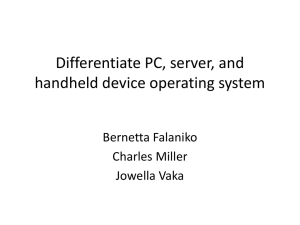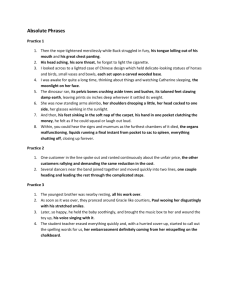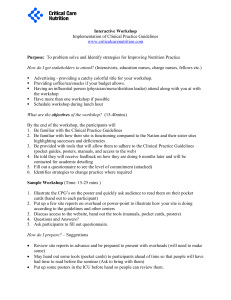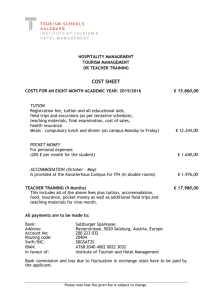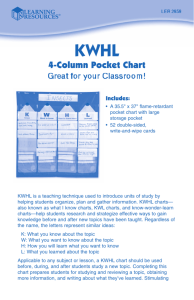PDAs & Mobile Devices
advertisement
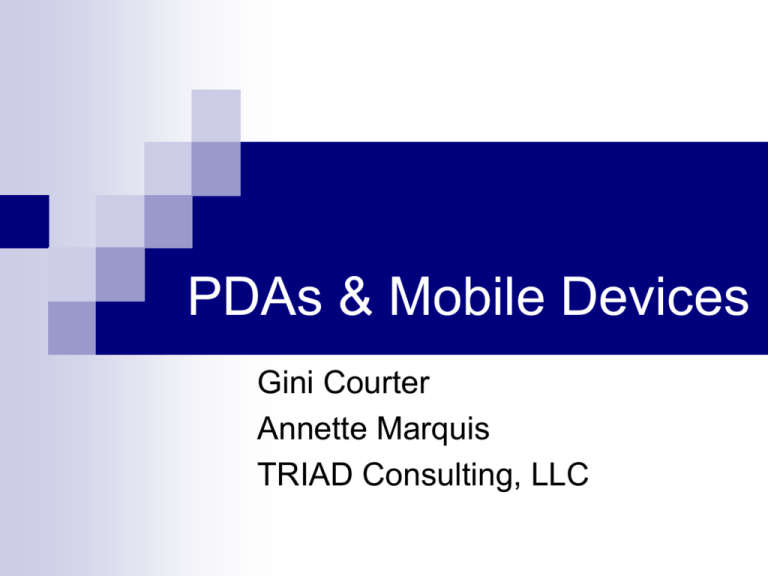
PDAs & Mobile Devices Gini Courter Annette Marquis TRIAD Consulting, LLC What are PDAs? A Personal Digital Assistant or PDA is a handheld computing device that has a monochrome or color display and a pen-like stylus to navigate and in most cases, to input data. Common Features of PDAs PDAs have a processor (206 mhz or less) and a combination of ROM, RAM and storage cards to store applications and data. PDAs do not have hard drives so the operating system and other built-in applications are stored in ROM so they don’t take up active RAM space. PDAs today have as little as 2MB and as much as 32MB ROM. RAM is used to store additional applications and all of your data. PDA’s come with anywhere from 8 to 64 MB RAM. Storage space can be greatly increased, however, with the use of expansion cards such as CompactFlash, SecureDigital (SD) and memory sticks. Primary styles of PDAs Palm-type devices Handheld PCs Palm PCs Palm-type devices, such as the Palm m505, the Handspring Visor Pro and the Compaq iPaq. These devices are generally less that 5.3 inches tall, 3.2 inches wide and .7 inches deep. Palm Operating System Used on the Palm PDA’s made by 3Com, Handspring, and Sony Clié. Palm PDAs Pocket PC Operating System Pocket PC (PPC) Microsoft’s OS used on Compaq iPaq, Hewlett-Packard Jornada, and Toshiba Pocket PC. Handheld PCs Handheld PCs, such as the HP Jornada 720 and the NEC Mobile Pro 790 HPCs. These devices include an integrated keyboard and a horizontal rather than vertical screen. Handheld PC 2000 Operating System from Microsoft based on the Pocket PC format for handheld PCs. Earlier models used the WinCE operating system. How Do Palms, Pocket PCs and HPCs Compare? Price Functions and Integration with Office Size and Weight Battery Type and Battery Life Connectivity Price Devices with the Palm OS are generally less expensive than other PDAs ranging in price from $150 to $450. Pocket PC devices cost $500 - $600 and HPCs can go as high as $1,000. Price is directly related to the display type, i.e., monochrome or color, the amount of power, and the expansion capability. Functions and Integration with Office – Palm-Type Devices Palm OS devices include basic tools for calendaring, contacts, to do lists and notes. Some of the devices also include connectivity software and e-mail capability. Third-party software for the Palm is a growing market—all types of software are available for the Palm from productivity to games. You must install additional synchronization software to synch the data with Outlook. Many Palm products come with PocketMirror from Chapura. Functions and Integration with Office – Pocket and HPC Devices Pocket PCs and HPC’s are Windows devices so the software is familiar to Office users. Pocket Word, Pocket Excel, Pocket Outlook and Internet Explorer have many of the same features of their bigger siblings. No additional software is needed to synch with a desktop or laptop PC Easily handle synching to multiple machines—a valuable tool in moving data between office and home PCs. The Pocket PC and Handheld PC 2000 operating systems are newer than the Palm OS so third party vendors are a little behind in software development. Size and Weight Thin and light is in and not just in body image! The Palm m500, m505 and m515 are great examples of products that easily slip into a pocket or purse and are hardly noticeable. For the most part, Pocket PCs are slightly heavier (as much as 2 ounces) and a bit bulkier. The height of a Pocket or Handheld PC can vary as much as a half inch from the Palms. The width may be only three-tenths of an inch but this difference can be significant in a smaller hand. Be sure to hold the device you are considering before purchasing it to see how it feels and how easy it is to hold. A device that’s too big can be uncomfortable and difficult to use. Battery Type and Life Most PDAs come with rechargeable lithium batteries. Palm-type devices require less energy so batteries typically last longer. Pocket and Handheld PCs, with their color screens and resource intense applications, drain batteries much faster. Lithium batteries last from a week to a month with intermittent use. They recharge easily in a couple of hours by placing them in their synch cradle or plugging them in with a charging cable. Some of the lower-end Palm-type devices use AAA batteries. Battery life can be as long as a couple of months but if you haven’t synched recently and you don’t change the batteries before they die, you lose all your data. Connectivity Landline Connections Wireless Connections Land-line Connections Handheld PCs such as the HP Jornada 720 come with a built-in modem so going online is a piece of cake - just plug in a phone cord and dial. For other devices such as Palms and Pocket PCs, you must purchase modems separately if you want to connect to the internet or your corporate network over the phone. You can purchase modems as CompactFlash cards and other PC cards, depending on the expansion slots available on your device. Ethernet cards are also available to connect directly to your corporate network. Wireless Connections Wireless Modems Bluetooth WiFi (802.11x networks) Mobile Phone Connections Multipurpose Devices BlackBerries and Other Mobile Solutions Wireless Modems Wireless solutions are available in the form of wireless modems such as the PocketSpider and the Minstrel. Both of these modems use a CDPD (Cellular Digital Packet Data) network and require a subscription service to use but offer complete freedom from landbased phone lines in their service areas. Bluetooth Any Bluetooth-enabled device, including phones, PDA’s, printers and computers can exchange data (up to 1 Mbps) with any other Bluetooth device within its range (up to 300 ft). You can add Bluetooth adapters to Palm devices and Bluetooth cards to Pocket and Handheld PCs. WiFi (802.11x Ethernet networks) 80211b wireless networks transfer data at 11 Mbps up to 500 ft. 802.11a Ethernet networks work at 54 Mbps and cover a range of 1000 ft but may be overkill for PDAs because the card slots can’t handle data at that speed. Mobile Phone Connections Another way to connect to the Internet without a land-based phone line is through a cable or Bluetooth connection to your mobile phone. If you plan to connect with a cable, you must have a mobile phone with: Internet capability cable designed to connect with you PDA. Not all combinations exist so check out www.mobileplanet.com or your mobile phone vendor to verify that the two can connect. Multipurpose Devices Sprint offers a phone that is integrated with a Palm OS device (PalmPowered Sprint PCS Phone) Handspring makes a Palm device (Handspring Treo Communicator 180 and 270) that is integrated with a phone. Microsoft Pocket PC Phone Edition. BlackBerries and Other Mobile Solutions Research in Motion, Inc. has created a new standard for mobile communication called RIM devices. BlackBerry Wireless Handheld Automatically interacts with your corporate Microsoft Exchange or Lotus Domino e-mail server to send and receive e-mail, update your calendar, tasks and contacts from wherever you are. The Blackberry 5810 also interacts with ISP accounts to send and receive mail. Higher level of security and instant connectivity from anywhere in the Blackberry service area. Blackberry service is available from AT&T Wireless at http://www.attwireless.com/mobilepro/ blackberry/ and VoiceStream Wireless at http://www.voicestream.com/blackberr y/ and in Canada at Rogers AT&T Wireless. To find out more about mobile solution products, visit: Mobile Solutions: www.mobilesolutions.com PDABuyers.com: www.pdabuyersguide.com Bizrate.com: www.bizrate.com Pocket PC Resources Microsoft Mobile www.microsoft.com/mobile/pocketpc/default.asp Evaluation information Free downloads Club PocketPC Security Information
